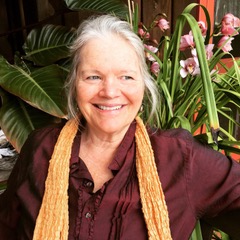Spring Issue Articles
In a world dominated by the intellectual and imaginal mind, the body can be shunted to the background as something that’s dumb, numb, inconvenient or untrustworthy. But, what if this is an illusion and the body is intelligent, responsive, and reliable? What if listening to the body could be a way to discover your deepest truth?
Like most people, you’re probably more familiar with your smart mind than your smart body. This leaves a whole bunch of valuable awareness on the table that inform your everyday life as well as your well-being. To access all of your resources, you’ll need to get out of your head and in to your body. Paying attention to the intricacies of what you see, hear, and smell is a good place to start. Including your body in the full scope of awareness forges a new perspective- a body- oriented perspective. Once you find the way and tune in, listening to the body is akin to learning a new language.
Your body communicates with sensation rather than actual words. Because it’s non-verbal, you’ll need your mind to help translate its straight-forward, symbolic communication. Let your mind be the astute observer and interpret what your body’s feeling. Often, if you’re patient and take the time to listen in, without prejudice, the words to describe your experience are body-centered and illuminating. Use your imagination and the richness of cultural experience to help connect the dots and find meaning. Remember, the body is both literal (the heart is the heart) and metaphorical (the heart represents love). Making your own connections will help you find the message and insights that are relevant to you.
In my body therapy practice, I use three exercises to help people listen to their body. With follow-up assignments to take home, these body-centered explorations offer simple ways to become familiar and comfortable with the sentient body. Designed for therapists, clients, and any interested reader, learning to pay attention and understand the unique ways the body communicates is the first step in a therapeutic conversation.
Exercise One: What does your internal dialogue tell you about your relationship with your body?
Take a moment right now and see where you stand with your body. Close your eyes and bring your awareness to your inner experience. Do you feel intimate, comfortable and confident in this physical space? Place a hand on your abdomen. Do you feel connected and loving? Or, are you distant, awkward, or judgmental? When you speak about your body, are your words respectful and generous? Are you as kind and loving to your own body as you would be with a dear friend?
Remember, the body is both literal (the heart is the heart) and metaphorical (the heart represents love).
The way you answer these questions isn’t random. Your descriptive words are part of an internal dialogue and reveal something important about your relationship with your body. Recording a few key words and phrases is a good way to initiate a deeper understanding for your journey. As the therapeutic conversation continues, returning to this simple exercise is a good way to track your progress, uncover deeper layers, and recalibrate your internal dialogue. In a very real way, the body is listening to everything your say and think. What message do you want it to hear?
 Assignment: Listen in to your internal dialogue over the next week and consciously change the tone and content to reflect love and respect. Stop “dissing” your body—dismissing, disrespecting, and disregarding. Start “inning”— inhabiting, inspecting and including. Even if it feels unusual or awkward, just do it! Being proactive in creating a positive relationship with your body is a brand new approach and something you’ll need to practice. When you change the internal conversation, it shifts the perspective to reveal what needs to be healed. In addition, seeing things from a new angle can offer new insight, new creativity, new solutions, and renewed enthusiasm.
Assignment: Listen in to your internal dialogue over the next week and consciously change the tone and content to reflect love and respect. Stop “dissing” your body—dismissing, disrespecting, and disregarding. Start “inning”— inhabiting, inspecting and including. Even if it feels unusual or awkward, just do it! Being proactive in creating a positive relationship with your body is a brand new approach and something you’ll need to practice. When you change the internal conversation, it shifts the perspective to reveal what needs to be healed. In addition, seeing things from a new angle can offer new insight, new creativity, new solutions, and renewed enthusiasm.
Exercise Two: Use your body sense and answer the question “What’s Happening Now?”
Pause for a moment to drop in and see how the interior space feels. Letting your awareness be your guide, explore the qualities of space and sensation. Making a note of where tension lives and how full, empty, crowded, comfortable you feel. Although not as well-known as the other senses, your kinesthetic or sense of internal-external space lets you know the particulars of how your body feels. To use this sense, you’ll want to close your very active eyes and ask yourself the following:
-
- Do I feel comfortable and at ease?
- Is some part of my body tightened up, squeezed off, or tucked under?
- Are my ribs moving with each breath- front, back and sides?
- Do I feel my pelvis on the chair, my feet on the floor?
- Am I aware of where my body is in relationship to the space around me?
Listen to the feedback from your body and expand the conversation using your imagination to connect the dots. For instance, if you’re not at ease, this could be due to stored history or emotional content. If you’re breathing in a limited range, perhaps you’re not showing up for the fullness of life. If you’re mostly in your head, how can you hear gut instinct or your heart’s desire?
Assignment: Tune in and pay attention at key times during the week, such as in the interlude between work and rest. Use your body’s sense of internal space to listen to what’s going on. If you’re occupying less than full space, determine if this is due to habit or circumstance. If due to habitual holding, what are you holding in, holding back, or holding on to? If due to circumstance, what is your emotional body telling you?. For instance, is your inner space open to an idea or shrinking away? Does a situation make your stomach feel jumpy or relaxed? Listening to your body is like hearing an inner voice. When you learn to trust and include its guidance, you strengthen the circuitry for intuition.
Exercise Three: The Body Home Tour
Close your eyes, connect to your internal sense of space, and take your curious mind on a tour of the premises. Imagine that you’re visiting different rooms of a house as you go from your head to your neck to your upper chest, etc. As you pause along the way and take stock, make a note of varying qualities (awareness, comfort, familiarity) and answer the following questions:
-
-
- Do some places feel more like home than others?
- Are some places bright, shiny, warm, cozy while others are messy, dark, and cobwebby?
- Are some places triggered with emotions or memories?
- Do some places have something they need to say or want you to hear?
-
There’s a cache of rich information here. In a profound way, your body holds the story. Even if it feels numb, blank, or unapproachable, it’s telling you something. Jot down some descriptive words to note how you felt as you toured your body home. Be sure to include anything that surprised you and everything your body had to say. Taking this tour increases your familiarity with your body and lets you know what healing needs to be done.
Assignment: Check in with your body home a couple of times over the next week. Setting an intention for healing, go to a particular place that caught your interest and linger there for a bit of time. Using your hands, breath and imagination, do some basic house cleaning. A dense place might need some breath to free it up; a musty, dark place might need some light; an emotionally charged place might appreciate the comfort of your loving hands. If you run into some old attitudes or emotional detritus along the way, just sweep it out the door with successive exhales.
 Developing a relationship with your body-self aligns you with your inner self. You might be surprised by the depth and complexity of your body’s truth. Learning how to listen to the straight-forward message demystifies the body and opens a doorway to deep transformative work. These body-oriented exercises have introduced the mind to the body in a very tangible, unthreatening way. You can count on your body to deliver a simple, no BS truth. Each time your mind acknowledges its validity, your body voice gets just a bit clearer and more confident. Over time, you’ll discover that checking in and listening to your body gives you access to the most personal, present, constant part of who you are.
Developing a relationship with your body-self aligns you with your inner self. You might be surprised by the depth and complexity of your body’s truth. Learning how to listen to the straight-forward message demystifies the body and opens a doorway to deep transformative work. These body-oriented exercises have introduced the mind to the body in a very tangible, unthreatening way. You can count on your body to deliver a simple, no BS truth. Each time your mind acknowledges its validity, your body voice gets just a bit clearer and more confident. Over time, you’ll discover that checking in and listening to your body gives you access to the most personal, present, constant part of who you are.
Once trust and familiarity are established, deeper layers of emotional and physical healing can be approached without unnecessary overwhelm. Even when grappling with the most disturbing content and painful emotional healing, when an awakened body consciousness is on board, you have a valuable ally and safe container for the therapeutic conversation.
 Ann Todhunter Brode has been an Aston Patterning practitioner and body-oriented therapist in Santa Barbara for over forty years. A recognized master in her field, she is dedicated to helping people understand and feel comfortable in their bodies. In addition to her clinical practice, Brode shares her personal and professional experience through down-to-earth, compassionate articles on the challenges & rewards of living consciously in the body. Her recently completed book, A Guide to Body Wisdom- What Your Mind Needs to Know About Your Body (Llewellyn Worldwide) is available through local booksellers and online.
Ann Todhunter Brode has been an Aston Patterning practitioner and body-oriented therapist in Santa Barbara for over forty years. A recognized master in her field, she is dedicated to helping people understand and feel comfortable in their bodies. In addition to her clinical practice, Brode shares her personal and professional experience through down-to-earth, compassionate articles on the challenges & rewards of living consciously in the body. Her recently completed book, A Guide to Body Wisdom- What Your Mind Needs to Know About Your Body (Llewellyn Worldwide) is available through local booksellers and online.
More information can be found at https://www.llewellyn.com/product.php?ean=9780738756950
www.bodywisdomforlife.com www.facebook.com/bodywisdomforlife







